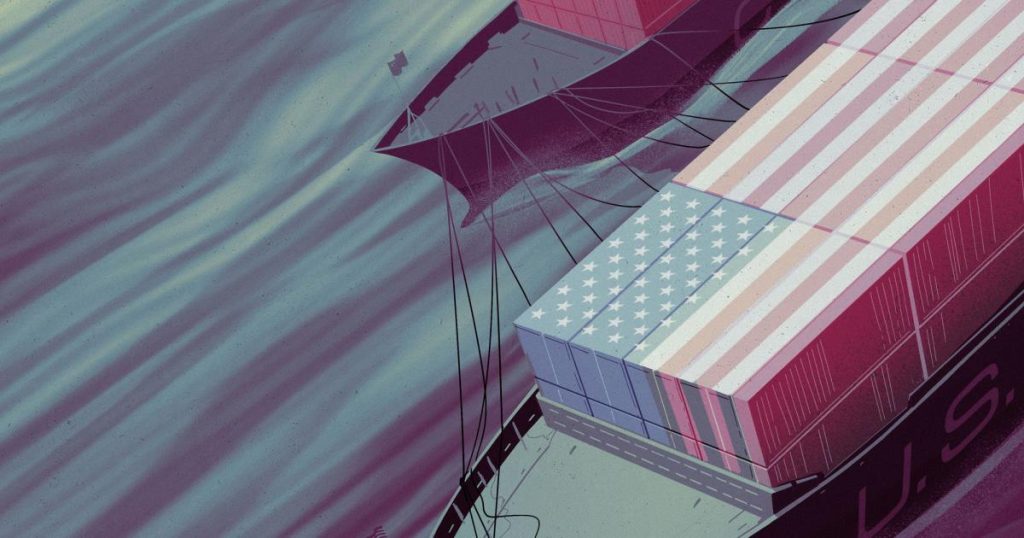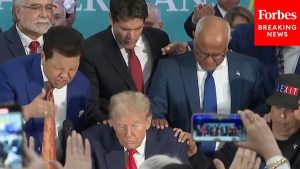The geopolitical competition between China and the United States is the defining issue in international politics. It is a contest between the world’s largest economies. It pits two dramatically different political systems—one democratic, the other authoritarian—against each other. And it is taking place in almost every region.
According to most American analysts, this competition will be close. Although the pace of China’s rise has slowed, the conventional view in Washington is that China is already a peer, or at least a near peer, in economic power. “If we don’t get moving, [the Chinese] are going to eat our lunch,” quipped former U.S. President Joe Biden soon after his 2021 inauguration. In the same year, Elbridge Colby, whom current U.S. President Donald Trump nominated to be undersecretary of defense for policy, warned that “China’s economy is almost as large [as] or perhaps larger than America’s already.”
Yet the view that China is close to leveling the balance of economic power is incorrect. Chinese government statistics may indicate that the country is almost an equal of the United States. But if the economic power of the two countries is measured correctly, the United States still has a commanding and durable advantage. Its GDP is around twice as large as China’s. Its firms and the firms of its allies dominate global commerce and own or control much of China’s output, especially when it comes to advanced technologies. As a result, the United States has enormous leverage over Beijing. With that leverage, Washington could carry out a broad economic cutoff alongside its allies—in practice, a rapid decoupling—that would devastate China while doing far less short-term damage and almost no long-term damage to itself.
This fact has major strategic implications. The analysts who oppose a decoupling from China typically stress that doing so will impose massive, long-term economic disruptions on the United States. They are wrong. But it does not follow that decoupling now would be right. A peacetime decoupling would cost Washington one of the strongest tools it has to deter Chinese aggression. It might prompt China to lash out, starting conflicts that it would otherwise avoid. And it may fail to achieve its purpose: For an economic cutoff to cause disproportionate harm to China, the United States’ allies must participate; yet if Washington tries to move forward with a cutoff during peacetime, they will likely balk. U.S. policymakers must understand the United States’ real position in its competition with China—and keep its leverage intact for a crisis rather than undercutting one of the best weapons it has.
The Potemkin Economic Superpower
China’s economy has grown impressively over the past several decades. It is now unquestionably the world’s second largest, and it has become far more innovative than it once was. But it is not nearly as mighty as commonly purported in part because Beijing directly manipulates key economic metrics, including GDP.
According to official statistics, China’s gross domestic product is nearly $20 trillion, or just shy of two-thirds of U.S. GDP. But metrics that have not been artificially altered suggest it is far smaller. Consider nighttime satellite images of lights in the country—arguably the best approach for approximating Chinese GDP. Studies that look at such imaging reliably find less light concentration than one would expect if China’s official statistics were accurate. Indeed, an aggregation of the most rigorous of these studies indicates that China’s GDP is now overstated by around a third, which means the country’s GDP is only around half the size of that of the United States. By comparison, the Soviet Union reached a peak of 57 percent of U.S. GDP in 1975.
Experts in and outside China have long understood that China’s official GDP statistics are not credible. Li Keqiang, who served as China’s premier from 2013 to 2023, said in 2007 that he did not trust China’s “manmade” GDP figures, which were for “reference only.” Logan Wright and Daniel Rosen, China experts at the Rhodium Group, were even more damning. “In almost two decades of professional experience in this field,” they wrote in 2019, “we have never met a Chinese official who professed privately to actually believe the GDP data.”
Beijing directly manipulates key economic metrics, including GDP.
Much of the inflation of China’s GDP is caused by the singular nature of its development model. The country is uniquely dependent on heavy investment to fuel growth; according to the economist Michael Pettis, such investment has averaged over 40 percent of China’s GDP for the past 30 years. But much of this spending has no productive effect. For example, China now has the highest housing vacancy rate in the world, at 20 percent. A huge proportion of China’s infrastructure projects will end up costing more to build than they will ever generate in economic returns. According to the Wall Street Journal reporter Brian Spegele, for example, Beijing’s 30,000-mile high-speed rail network (an amount that could encircle the globe) has generated more than $1 trillion in debt and features many routes that are barely used. Such nonperforming investments, however, continue to buoy China’s GDP. In advanced economies, by contrast, if an investment cannot be paid off, it is frequently written off as a decrease in income, thus reducing GDP.
Even if Beijing’s GDP estimates were reliable, they would overstate China’s economic power. Many analysts are impressed by China’s vast economic output in manufacturing. But look beneath the surface, and much of this output is simple or not really under the country’s control. Production is far more intricate and far more globalized than in previous eras, especially in complex industries such as semiconductors and jet aircraft. As a result, the large multinational corporations at the top of global production chains command outsize influence in the global economy. And these firms are overwhelmingly based in the United States and allied countries, not in China.
This fact is illustrated by looking at the profits generated by the 2022 Forbes 2000—the world’s 2,000 largest companies. Profits are the preferred measure of economic power because if a firm in a sector is generating them, it likely means there are barriers preventing competitors from entering the market and cutting into that company’s margins. They thus best capture the chokepoints of the world economy. And U.S. firms generated 38 percent of global profits, while firms headquartered in allied countries generated 35 percent. Chinese firms, including those in Hong Kong, generated just 16 percent.

A closer look at the 27 industries in the Forbes 2000 makes the U.S. lead over China even clearer. China leads in three of these industries. The United States, meanwhile, leads in 20 of them, almost always by double digits. In three of the seven industries in which the United States is not the leader, an American ally is. Together, the United States and its allies and partners make up all the top five countries in terms of profit share in five industries: aerospace and defense, drugs and biotechnology, media, semiconductors, and utilities.
The United States’ edge is especially pronounced in high-technology sectors such as aerospace and defense, drugs and biotechnology, and semiconductors, in which U.S. firms generate 55 percent of profits, and the firms of American allies generate 29 percent. Chinese high-technology firms, by contrast, generate a mere six percent of profits worldwide—just slightly larger than the share generated by those of South Korea. Profits from Chinese firms are overwhelmingly concentrated in domestically focused sectors that lack geopolitical significance, notably banking, construction, and insurance.
U.S. companies and those of allied nations do, of course, make many of their products in China. But for Beijing, this is precisely the issue: much of China’s advanced manufacturing consists of output that is created and designed by foreign firms, including Apple, Bosch, Panasonic, Samsung, and Volkswagen. When these firms do not set up their own factories in China, they often hire other foreign firms—such as Taiwan’s Foxconn—to do so on their behalf. And regardless of who owns the advanced manufacturing in China, the country’s output is typically heavily dependent on technologies, expertise, and parts from the United States and its allies.
To see this dependence in action, consider the production of the iPhone 14, for which comprehensive manufacturing data is now available. The iPhone is assembled in China, so it counts as a Chinese export in official measurements and consequently adds many billions of dollars a year to the U.S. trade deficit (an estimated $10 billion in 2018). But it makes no sense to count the iPhone as a Chinese export because Chinese firms constitute a relatively insignificant part of its production. The phone is designed in California. It is assembled in factories owned by a Taiwanese company. And Chinese firms contribute just four percent of the value of its components. Ahead of China’s contribution are South Korea (25 percent), Japan (11 percent), and Taiwan (7 percent). Number one is the United States, which contributes 32 percent of the value of the iPhone’s components.
From an economic welfare standpoint, whether China’s production is owned or controlled by foreign firms does not matter. As long as it occurs in China, it contributes to the growth of China’s economy and the well-being of its citizens. But from a geopolitical standpoint, this distinction is vital. Foreign companies are not obligated to operate in China if it is no longer in their interest or if their home governments force or incentivize them to leave. The same is true for foreign suppliers of parts. They, too, cannot be forced to continue selling their wares in China if they see it as disadvantageous or if their governments prevent them from doing so.
MEANS OF PRODUCTION
So far, Washington’s attempts to cut off China have been highly targeted in nature, focusing on technology restrictions. But to determine what would happen if the United States and its allies imposed a broad economic cutoff, we carefully modeled the costs of decoupling, designing 12 hypothetical scenarios by varying three parameters: whether Taiwan was still part of the global economy or was taken out via Chinese conquest, blockade, or bombardment; the degree to which China’s trade with the United States and its allies was cut off; and the extent of the damage these trade disruptions inflicted on global supply chains.
We tested these scenarios to estimate the damage of trade disruptions in the short run—the weeks and months following their onset. In all 12, we found that China would suffer economic pain massively disproportionate to that of the United States. At the low end, the near-term economic disruptions to China would be around five times as large as the disruptions to the United States. At the high end, they would be around 11 times as large.
This translates to stomach-turning, Great Depression–like upfront costs for China, with its short-run economic disruptions affecting between 15 and 51 percent of the country’s GDP (depending on the scenario). In our baseline model in which all of China’s maritime trade is restricted via a distant naval blockade, for example, 39.9 percent of China’s GDP would be disrupted, but only 3.6 percent of U.S. GDP would be. Beijing, in other words, could sanction every single American industry and person, and the damage to the U.S. economy would, at most, be a tiny fraction of the damage that Washington and its allies can inflict on China.
China can be cut off only once.
To determine the long-term consequences of reduced economic interchange, we also modeled how global trade would eventually settle after the initial shock of decoupling, and how this new equilibrium would shape each state’s growth trajectory. In doing so, we found that Washington’s position would become even more comparatively favorable. The United States and almost all of its allies would return to their baseline level of growth. China’s economic trajectory, however, would permanently decline.
The key reason for this enduring imbalance is simple. China’s economy greatly depends on foreign firms producing goods within its borders or subcontracting with Chinese firms that do. The cutoffs would rip that production away. American companies and the companies of U.S. allies, meanwhile, are not so reliant. U.S. and allied trade and production would face short-term logistical troubles after a decoupling, but they can be rerouted away from China as firms find alternative factories to make their wares and locate other sources for basic parts. (Although some of China’s lost production might one day return, much would remain elsewhere once foreign companies went through the trouble of creating new supply lines.)
In fact, American firms and the firms of U.S. allies operating in China are already pursuing diversification. If a broad wartime economic cutoff were imposed on China, many companies would simply hasten this process. And because all Western firms would simultaneously face pressure to diversify from China, their concerns over being placed at a disadvantage by moving production before their competitors would be negated.
TIME, PLACE, AND MANNER
Former U.S. President Joe Biden’s administration sought to pursue a “small yard, high fence” approach to its economic relationship with China: greatly curtailing interchange only in the sectors most critical to national security, such as semiconductors. This strategy was motivated by the desire to, in the words of Biden’s National Security Adviser Jake Sullivan, “maintain as large a lead as possible” in the most crucial high-technology areas while otherwise benefiting from trade relations with China.
Yet this approach was not aggressive enough for many China hawks. To them, using a scalpel to “de-risk” supply chains will not adequately protect Americans from the dangers China poses; they believe the economies of the United States and China should instead be thoroughly decoupled. They claim that significant economic interchange with China presents intolerable risks—whether by strengthening Beijing, harming industrial communities within the United States, or causing generalized tension between the U.S. free-market system and the Chinese state-controlled one. These advocates now have a receptive audience in the White House. On the campaign trail, U.S. President Donald Trump proposed 60 percent tariffs on Chinese imports. He has suggested erecting even more drastic barriers, or even a complete shutdown if Beijing attacks Taiwan.
Undertaking a broad economic cutoff in response to Chinese territorial revisionism would be sensible. But using this approach in peacetime is altogether different and strategically unwise. China can be cut off only once, and doing so in the absence of conflict would squander vital leverage for constraining military aggression by Beijing. Unlike Russia, China is heavily integrated into global markets. It enjoys massive economic benefits from globalization that will be costly to forgo. With a substantial economic relationship left intact, Washington can signal to Beijing that it will benefit if it refrains from challenging the status quo but that China would incur massive economic retaliation should it tread the path of aggression. The United States should thus keep its economic powder dry until a moment of true crisis.

Decoupling preemptively could also cause exactly the U.S.-Chinese conflict policymakers want to avoid. If the United States initiates large-scale peacetime cutoffs, and China believes it cannot effectively replicate many of the goods and technologies it stands to lose, it may sense that its window of opportunity to attack Taiwan is closing. That may prompt it to decide to use force quickly—especially since it would have less at risk if its global economic access were already set to be curtailed.
Finally, a broad peacetime decoupling might fail. To inflict massive, disproportionate harm on China, Washington needs its allies to participate in cutoffs; if the United States decouples by itself, the short-term disruptions to China’s GDP would be between just five and seven percent, only a hair above the four to five percent disruption to U.S. GDP under those circumstances. And in the absence of a crisis, Washington’s partners will likely be reticent to join in. Although the United States may suffer relatively little from cutting off China, many of its partners would pay a hefty price. Germany, for instance, would see around twice the level of economic disruption as the United States, Japan would see around three times as much damage, Australia around five times, and South Korea around seven times.
The United States could, of course, try to force its allies to cooperate by deploying secondary sanctions or using its naval assets to restrict China’s trade. But even if successful, such an effort would likely be penny-wise and pound-foolish, leading U.S. allies to turn away from Washington in the long term. The United States’ alliances are an incredible power resource, and its actions should not undermine them.
Washington should therefore stick to a de-risking approach and deploy a broad economic cutoff against China only if Beijing makes a severe, economically costly breach of the status quo. If China blockades or invades Taiwan, the short-term economic disruptions to the United States and its allies would be large enough to rival the losses caused by a broad decoupling. The additional pain from cutting off China might then appear marginal and strategically worthwhile to U.S. allies, particularly if Washington is pushing them.
SAFETY IN NUMBERS
To be ready to meet such a moment, however, the United States and its allies need a shared economic strategy. And at present, their coordination on economic statecraft is essentially ad hoc. Washington and allied governments began extensively planning how to sanction Russia after they learned, in October 2021, of its intent to invade Ukraine. But with China, they may not have as much notice, and whatever aggression they confront could be less blatant. Just as NATO undertakes preparatory actions over the long term—training, planning, allocating resources, and so on—to ensure effective military cooperation, Washington and its allies should now coordinate on how to wage economic war.
There are many ways to facilitate such collaboration. The best would be to create a formal economic alliance via a new intergovernmental organization. A vital function of this alliance would be to reduce uncertainty about whether its members would conduct a joint decoupling in response to Chinese territorial revisionism. Given that the costs of a broad cutoff vary greatly across countries, it is reasonable to wonder whether the most vulnerable ones would participate. Thoughtful planning within the alliance would reduce this uncertainty, in part by finding ways to assist the states that could suffer the most. For example, the alliance could plan for countries with large stockpiles of key resources to distribute them to more exposed members. To that end, Washington and its allies should strive to understand which of them can best disburse stockpiles or surge production of goods now supplied by China. They should plan how such a surge would occur and how such production would be distributed.
The alliance could also consider even more extensive forms of cooperation. It might, for example, plan how to coordinate fiscal and monetary policies during a crisis or how to seize and distribute the assets of countries (including China) that breach the territorial status quo. They could establish a collective financial reserve fund that members would draw on to mitigate the most severe damage of a cutoff. The reserve could even help resolve difficult questions about whether Washington’s allies spend enough money on defense. U.S. officials could offer to treat such contributions to a reserve fund, for example, as an alternative to an increase in defense spending.
Decoupling preemptively could cause exactly the war policymakers want to avoid.
Washington’s investment in a new economic alliance, however, cannot come at the expense of its existing security alliances, especially with Europe. An increasing number of politicians seem to think protecting Asia from China is mutually exclusive with protecting Europe from Russia. Vice President JD Vance, for example, has criticized the American military presence on the continent by arguing that resources invested there would be better used to constrain China’s capacity for military aggression. But this reasoning falsely assumes that constraining China is an objective achieved exclusively via military means. Shaping China’s security behavior and capabilities also requires economic tools, which means the United States needs Europe. The continent is home to a large share of the world’s leading firms, and any economic cutoff of China will be ineffective unless European countries participate.
The Biden administration’s effort to deny China advanced semiconductors is a case in point. For this restrictive policy to be effective, Washington had to obtain the cooperation of the Dutch firm ASML, the only company that makes the extreme ultraviolet lithography machines essential for manufacturing advanced semiconductor chips. ASML eventually agreed to American demands that it cease exporting these machines to China. But in the absence of a strong U.S. security role in Europe, it is doubtful that Washington’s intense lobbying campaign would have been successful.
Washington would therefore be wise to sustain its investment in NATO. It can even treat that commitment as the basis for a new understanding of the transatlantic bargain. In it, Europe would continue to receive needed military assistance from the United States concerning Russia, especially with respect to capabilities that would be too costly or politically difficult for the continent to develop on its own—such as a nuclear deterrent and cyberweapons. In exchange, Washington would receive Europe’s help with respect to economic policies constraining revisionism by Beijing.
READY, SET, . . . GO?
Although Washington’s allies would be far more exposed in an economic cutoff of China, the United States is hardly free of vulnerabilities. Certain American industries would be greatly harmed by a broad economic decoupling—most notably the agricultural sector, which exports a significant amount of goods to China. It would be wise for Washington to plan not just how to protect its partners’ economies but also how to protect its own. This planning would be vital to the smooth provision of government assistance to vulnerable industries in the event of a cutoff, and it would reassure leaders in those industries that they can survive a decoupling.
One important way to protect U.S. industries is by stockpiling more natural resources. It is the key area in which China has major economic leverage over the United States. But that is only because Washington has chosen to leave itself exposed, a problem it can and should rectify. The Department of Defense has a reserve of critical resources for use in national emergencies: the National Defense Stockpile. But this is intended to offset supply disruptions only in defense and vital civilian sectors—not in the economy overall. To protect the country more broadly, the United States needs to increase its natural resources stockpile to Cold War levels, roughly ten times as large as it is now. Such a step would have enormous strategic benefits and will cost relatively little, probably not much more than the price of a new aircraft carrier. At the same time, Washington needs to better incentivize the development of substitutes for natural resources now sourced from China, such as the rare-earth metals gallium and germanium. And where possible, the United States should augment the domestic extraction and processing of critical natural resources.
Washington would also be wise to identify additional areas in which the country is vulnerable to supply cutoffs from China and push forward with appropriate remediation steps—as it eventually did with respect to personal protective equipment during the COVID-19 pandemic. The U.S. government will need to hire more officials to examine their country’s ever-changing economic vulnerabilities. In fact, Washington should create a new institutional structure to foster more long-term planning and coordination regarding economic security issues. It could, for example, create new, dedicated economic security groups within the Treasury and Commerce Departments and the National Security Council that are each overseen by a political appointee—as has been suggested by Justin Muzinich, the former deputy secretary of the U.S. Treasury.
These new officials and institutions might finally recognize that China is far from leveling the balance of economic power with the United States and that Washington has vast economic leverage over Beijing. If the United States expends this leverage in peacetime, it could jolt China into acting on its territorial ambitions while costing Washington vital friendships. But if the United States holds this leverage in reserve, it could help keep Chinese revisionism in check. In doing so, it could narrow the range for catastrophic miscalculation between Beijing and Washington.
Loading…








